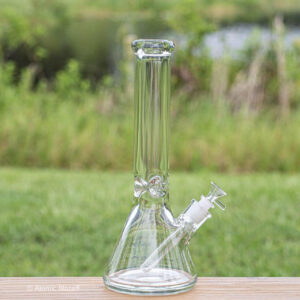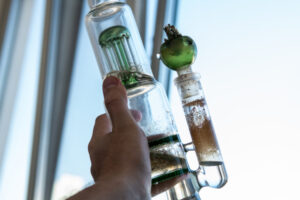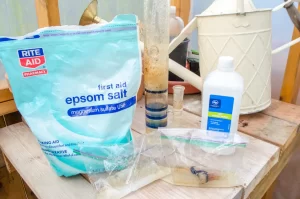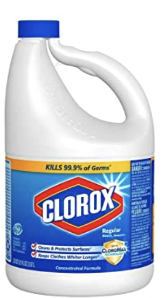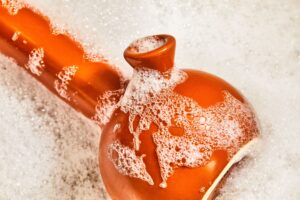If you own a bong, you know how convenient and enjoyable it can be for smoking your favorite herbs.
However, over time, bongs can get dirty and clogged with resin, which can affect their performance and your smoking experience.
In this article, we will explain how to clean a bong to remove built-up resin and other contaminants and help keep it in good working condition.
How To Clean A Bong
Cleaning a bong is an important step in maintaining its performance and ensuring a smooth, enjoyable smoking experience. Here’s how to clean your bong:
- Gather your supplies: You will need a pipe cleaner or a small brush, a container of warm water, and some rubbing alcohol. You may also want to have some salt on hand to help scrub away stubborn resin.
- Remove the bowl and down stem: These parts can typically be removed by gently twisting them counterclockwise. If they are stuck, you may need to use a pair of pliers to gently loosen them.
- Clean the bowl and downstem: Use a pipe cleaner or a small brush to scrub away any resin or debris that may have accumulated on the bowl and downstem. You can also soak them in rubbing alcohol to help loosen and remove the resin.
- Clean the bong: Fill the bong with warm water and add a small amount of rubbing alcohol. Swirl the water around to help loosen and dissolve the resin. You can also add a small amount of salt to help scrub away stubborn resin.
- Rinse and dry: Once the bong is clean, rinse it thoroughly with warm water and dry it with a towel. Be sure to dry the bong thoroughly, particularly the bowl and downstem, to prevent the growth of bacteria.
By following these steps, you can effectively clean your bong and keep it in good working condition. Regular cleaning of your bong is important to ensure a smooth, enjoyable smoking experience.
How Do You Clean A Glass Bong Without Rubbing Alcohol And Salt?
If you don’t have rubbing alcohol and salt on hand, you can still effectively clean your glass bong using other household supplies. Here’s how:
- Gather your supplies: You will need a pipe cleaner or a small brush, a container of warm water, and some baking soda.
- Remove the bowl and downstem: These parts can typically be removed by gently twisting them counterclockwise. If they are stuck, you may need to use a pair of pliers to gently loosen them.
- Clean the bowl and downstem: Use a pipe cleaner or a small brush to scrub away any resin or debris that may have accumulated on the bowl and downstem. You can also soak them in warm water and baking soda to help loosen and remove the resin.
- Clean the bong: Fill the bong with warm water and add a small amount of baking soda. Swirl the water around to help loosen and dissolve the resin. You can also use a small brush or a pipe cleaner to scrub away stubborn resin.
- Rinse and dry: Once the bong is clean, rinse it thoroughly with warm water and dry it with a towel. Be sure to dry the bong thoroughly, particularly the bowl and downstem, to prevent the growth of bacteria.
By following these steps, you can effectively clean your glass bong without the use of rubbing alcohol and salt. Regular cleaning of your bong is important to ensure a smooth, enjoyable smoking experience.
What Should You Not Clean A Bong With?
There are several things that you should not use to clean a bong:
- Harsh chemicals: Avoid using harsh chemicals such as bleach or ammonia to clean your bong. These chemicals can be abrasive and may damage the glass or plastic of your bong over time. In addition, the fumes from these chemicals can be harmful if inhaled.
- Abrasive materials: Avoid using abrasive materials such as steel wool or scouring pads to clean your bong. These materials can scratch the surface of your bong and may leave behind small particles that can be difficult to remove.
- Hot water: Avoid using hot water to clean your bong if the bong is made of a fragile material such as glass. Hot water can cause the bong to become brittle and break, particularly if the bong is subjected to rapid temperature changes.
- Dishwasher detergent: Avoid using dishwasher detergent to clean your bong. The harsh chemicals and high heat of the dishwasher can damage the glass or plastic of your bong over time.
By avoiding these materials and cleaning agents, you can help protect your bong and keep it in good working condition.
Can You Use Regular Salt To Clean A Bong?
Yes, you can use regular salt to help clean a bong.
Salt can be used to help scrub away stubborn resin and other contaminants that may have accumulated in the bong. To use salt to clean a bong, follow these steps:
- Gather your supplies: You will need a pipe cleaner or a small brush, a container of warm water, and some salt. You may also want to have some rubbing alcohol on hand to help loosen and dissolve the resin.
- Remove the bowl and downstem: These parts can typically be removed by gently twisting them counterclockwise. If they are stuck, you may need to use a pair of pliers to gently loosen them.
- Clean the bowl and downstem: Use a pipe cleaner or a small brush to scrub away any resin or debris that may have accumulated on the bowl and downstem. You can also soak them in warm water and salt to help loosen and remove the resin.
- Clean the bong: Fill the bong with warm water and add a small amount of salt. Swirl the water around to help loosen and dissolve the resin. You can also use a small brush or a pipe cleaner to scrub away stubborn resin. If you have rubbing alcohol on hand, you can also add a small amount to the water to help loosen and dissolve the resin.
- Rinse and dry: Once the bong is clean, rinse it thoroughly with warm water and dry it with a towel. Be sure to dry the bong thoroughly, particularly the bowl and downstem, to prevent the growth of bacteria.
Will Hydrogen Peroxide Clean A Bong?
Yes, hydrogen peroxide can be used to help clean a bong.
Hydrogen peroxide is a natural disinfectant that can help kill bacteria and remove stains.
To use hydrogen peroxide to clean a bong, follow these steps:
- Gather your supplies: You will need a pipe cleaner or a small brush, a container of warm water, and some hydrogen peroxide. You may also want to have some salt on hand to help scrub away stubborn resin.
- Remove the bowl and downstem: These parts can typically be removed by gently twisting them counterclockwise. If they are stuck, you may need to use a pair of pliers to gently loosen them.
- Clean the bowl and downstem: Use a pipe cleaner or a small brush to scrub away any resin or debris that may have accumulated on the bowl and downstem. You can also soak them in warm water and hydrogen peroxide to help loosen and remove the resin.
- Clean the bong: Fill the bong with warm water and add a small amount of hydrogen peroxide. Swirl the water around to help loosen and dissolve the resin. You can also use a small brush or a pipe cleaner to scrub away stubborn resin. If you have salt on hand, you can also add a small amount to the water to help scrub away stubborn resin.
- Rinse and dry: Once the bong is clean, rinse it thoroughly with warm water and dry it with a towel. Be sure to dry the bong thoroughly, particularly the bowl and downstem, to prevent the growth of bacteria.
Can You Clean A Bong With Bleach?
While bleach can be effective at killing bacteria and removing stains, it is generally not recommended for cleaning a bong. This is because bleach can be harsh and abrasive, and can damage the glass or plastic of your bong over time. In addition, the fumes from bleach can be harmful if inhaled, so it is important to use caution when working with this cleaning agent.
There are many other household products that can be used to effectively clean a bong, such as rubbing alcohol, hydrogen peroxide, vinegar, and baking soda. These cleaning agents are generally gentler on your bong and safer to use, and can be just as effective at removing resin and other contaminants. Regular cleaning of your bong is important to ensure a smooth, enjoyable smoking experience.
Can You Put A Bong In The Dishwasher?
It is generally not recommended to put a bong in the dishwasher.
This is because the heat and harsh detergents used in the dishwasher can damage the glass or plastic of your bong over time.
In addition, the high water pressure and vigorous scrubbing action of the dishwasher can cause the bong to become misshapen or break.
If you want to clean your bong, it is best to do so manually using warm water, a small brush or pipe cleaner, and a mild cleaning agent such as rubbing alcohol, hydrogen peroxide, vinegar, or baking soda.
How Do You Know If Your Bong Has Mold?
There are several signs that your bong may have mold:
- Musty smell: If your bong has a musty or moldy smell, it may be a sign that mold is present.
- Visible mold: If you see visible mold growing on the inside or outside of your bong, it is a clear sign that your bong has mold. Mold can appear as white, green, or black patches on the surface of the bong.
- Respiratory symptoms: If you experience respiratory symptoms such as coughing, sneezing, or difficulty breathing after using your bong, it may be a sign that your bong has mold.
If you suspect that your bong has mold, it is important to clean it thoroughly and remove the mold as soon as possible.
Using a moldy bong can be harmful to your health and can affect the quality of your smoking experience.
Can A Bong Soak Overnight?
Yes, it is generally safe to soak a bong overnight as long as you use a mild cleaning agent and the water is not too hot.
Soaking a bong overnight can help loosen and remove stubborn resin and other contaminants that may have accumulated in the bong.
However, it is important to use caution when soaking a bong overnight, as the water may become cold and cause the bong to become brittle and break.
To soak a bong overnight, follow these steps:
- Gather your supplies: You will need a container of warm water, a small brush or pipe cleaner, and a mild cleaning agent such as rubbing alcohol, hydrogen peroxide, vinegar, or baking soda.
- Remove the bowl and downstem: These parts can typically be removed by gently twisting them counterclockwise. If they are stuck, you may need to use a pair of pliers to gently loosen them.
- Soak the bong: Fill the bong with warm water and add a small amount of the cleaning agent. Swirl the water around to help loosen and dissolve the resin. You can also use a small brush or a pipe cleaner to scrub away stubborn resin.
- Soak overnight: Cover the bong with a towel or a plastic bag and leave it to soak overnight.
- Rinse and dry: In the morning, rinse the bong thoroughly with warm water and dry it with a towel. Be sure to dry the bong thoroughly, particularly the bowl and downstem, to prevent the growth of bacteria.
By following these steps, you can effectively soak your bong overnight and help remove stubborn resin and other contaminants.
Regular cleaning of your bong is important to ensure a smooth, enjoyable smoking experience.
Will Boiling Water Break A Bong?
Boiling water can potentially break a bong if the bong is made of a fragile material or if the water is too hot.
Bongs are typically made of glass, acrylic, or silicone, and each of these materials has different properties and tolerances to heat.
Glass bongs are generally the most fragile and may be more prone to breaking when exposed to boiling water.
Acrylic bongs are typically more durable and less prone to breaking, but they may still be at risk if the water is too hot or if the bong is subjected to rapid temperature changes.
Silicone bongs are generally the most durable and can withstand high temperatures, but it is still important to use caution when exposing them to boiling water.
To avoid breaking your bong, it is important to use caution when using boiling water to clean it.
Avoid exposing the bong to boiling water for an extended period of time, and be sure to gradually acclimate the bong to the temperature of the water to prevent thermal shock.
Regular cleaning and maintenance of your bong is important to help ensure it stays in good working condition.
Will A Bong Break In The Cold?
Bongs can potentially break in the cold if they are made of a fragile material or if they are subjected to rapid temperature changes.
Bongs are typically made of glass, acrylic, or silicone, and each of these materials has different properties and tolerances to temperature changes.
Glass bongs are generally the most fragile and may be more prone to breaking when exposed to extreme cold temperatures.
Acrylic bongs are typically more durable and less prone to breaking, but they may still be at risk if they are subjected to rapid temperature changes.
Silicone bongs are generally the most durable and can withstand extreme cold temperatures, but it is still important to use caution and handle them carefully to avoid damaging them.
To avoid breaking your bong in the cold, it is important to handle it carefully and avoid subjecting it to rapid temperature changes.
When transporting your bong in cold temperatures, be sure to wrap it in a protective covering or store it in a padded case to help cushion it against impacts.
Regular cleaning and maintenance of your bong is important to help ensure it stays in good working condition.
How To Clean A Bong – Key Takeaways
In conclusion, cleaning your bong is an important step to ensure a smooth, enjoyable smoking experience.
By following the steps outlined in this article, you can effectively clean your bong using common household supplies such as warm water, a small brush or pipe cleaner, and a mild cleaning agent such as rubbing alcohol, hydrogen peroxide, vinegar, or baking soda.
It is important to clean your bong regularly to remove resin and other contaminants that may have accumulated in the bong.
In addition, be sure to handle your bong with care to avoid damaging it, and avoid using harsh chemicals or abrasive materials to clean it.
By following these tips, you can help protect your bong and keep it in good working condition. So, regular cleaning and maintenance of your bong is important to ensure a smooth, enjoyable smoking experience.

